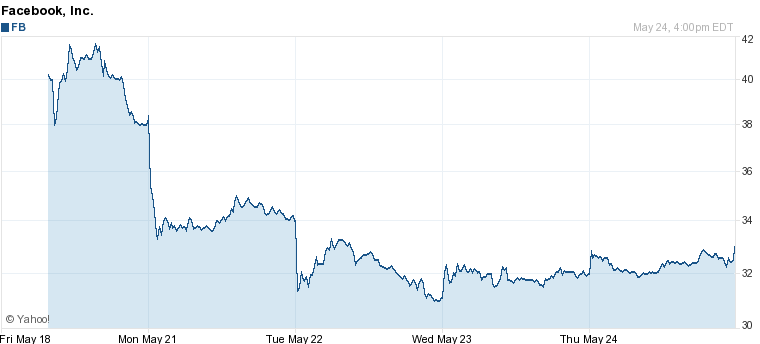 There’s been a ton of coverage about the Facebook IPO disaster, but very little of it looks at the crucial point two weeks ago where things went terribly wrong. It’s becoming increasingly clear that Facebook itself made a strategic blunder at that juncture.
There’s been a ton of coverage about the Facebook IPO disaster, but very little of it looks at the crucial point two weeks ago where things went terribly wrong. It’s becoming increasingly clear that Facebook itself made a strategic blunder at that juncture.

Above: Facebook CFO David Ebersman
The screw-up resulted in a major disappointment in Facebook’s stock debut: The stock’s 15 percent decline since the IPO last Friday may not in itself be tragic. But worse, lawsuits are flying saying that legal guidelines weren’t followed. And there’s the sad fact that regular mom-and-pop investors were apparently left with the more losses on average than large institutions who got privileged information. This all was aggravated by a separate annoyance: glitches in the Nasdaq stock market trading process, which caused delays in trade and cancel confirmations, among other things.
However, based on a number of interviews VentureBeat has had with observers and other sources close to the process, it’s apparent that Facebook itself may be most to blame for the fallout. Facebook chose to be more furtive in public announcements about its business than it was in private talks with large investors.
The “update”
The decisive action by Facebook came on May 9, three days into the “roadshow,” which is the time when Facebook and its bankers visit major investors in hopes of getting them to buy the IPO stock. On that day, Facebook’s executives, led by chief financial officer David Ebersman, signed off on new language in the company’s updated IPO prospectus.
In that May 9 update, Ebersman decided to use vague language when describing how the company’s second quarter was looking. It was extremely understated, considering what we would later find out. According to the filing, specifically on page 57, Facebook said that it was experiencing the same trend in the second quarter that it had seen in the first quarter, that growth in “daily active users” (DAUs) was increasing more rapidly than the growth in ad impressions, driven by many users’ shift to mobile devices.
The exact wording is here:
Based upon our experience in the second quarter of 2012 to date, the trend we saw in the first quarter of DAUs increasing more rapidly than the increase in number of ads delivered has continued. We believe this trend is driven in part by increased usage of Facebook on mobile devices where we have only recently begun showing an immaterial number of sponsored stories in News Feed, and in part due to certain pages having fewer ads per page as a result of product decisions.
Now Facebook is generally growing quickly — and its ads are growing, even if they are growing more slowly on mobile — and so this update itself didn’t send any alarm bells to most investors, and it shouldn’t have. After all, Facebook had long warned about this mobile problem, ever since the first IPO prospectus filing on Feb 1, that revenues could be negatively affected by its huge mobile growth, because monetizing mobile hadn’t been proven. (Indeed, VentureBeat was the first to report this on the day of the IPO filing.)
Facebook’s lawyers may, in the wake of the legal mess it has gotten into, try to argue that the new May 9 language about “DAU’s increasing more rapidly than the increase in number of ads delivered” pointed to something more significant than Facebook had released before. But the reality is that this wording was just too vague to be construed by normal people as meaning anything more than what had already been mentioned before. The sad thing is, if this was such an important update for Facebook, its team must have argued about it a hundred times before publishing. So why was it written as though it was purposefully trying to obfuscate? More on that in a sec.
First, there’s been sloppy reporting about the May 9 update, and it’s worth setting the record straight. The WSJ, the leading publication for many bankers, for example on Thursday implied that the May 9 update was the first time Facebook disclosed that the mobile risks “may negatively effect results.” But the WSJ is wrong. That wording had been in Facebook’s S-1s from the beginning. Take a look for yourself at the original February filing. (See pages 5 , 13, and 46.) The fact is, there is nothing within the S-1 update on May 9 that would give normal investors the sense that there had been a material change about Facebook’s revenue prospects.
The private guidance bombshell
The more significant point is, on the next day, May 10, Facebook made private statements to a select group of banking analysts, telling them the revenue prospects had changed. This was arguably material information at the time — a big no-no.
Here’s what happened on May 10: Facebook got on the phone with a select group of 21 analysts, including analysts of its IPO underwriters, and briefed them on what was really going on behind the S-1 update. Facebook executives guided those analysts through much more explicit material than the S-1 update contained, according to our sources, saying that Facebook now expected the second quarter to be on the “low end of the range” of the financial guidance Facebook had previously given them. VentureBeat has confirmed this wording with someone with direct knowledge of those talks.
Of course, this new information prompted the analysts to take a look at the guidance Facebook had previously given to them, then estimate where the “low end” was, and revise their own forecasts accordingly. They did this beginning on May 10, as disclosed by leaks to Reuters. The banks now forecasted 30.4 percent year-on-year 2012 revenue growth on average, instead of the 36.7 percent growth previously expected. (Compare that to 2011, when Facebook’s revenue grew 87.9 percent year-on-year to $3.71 billion.)
Let’s back up for a second. When Facebook gave its original guidance to analysts in March and April, at the start of the IPO process, it was on firm legal ground in doing so. Indeed, this guidance is a normal part of the process, described in good detail by Henry Blodget, himself a former Wall Street analyst, in his good post about the IPO process Tuesday. He covers a lot of ground that I won’t go over again here.
However, Facebook’s subsequent guidance to analysts, made on May 10, “to the low end” of the earlier guidance, was not on firm legal ground, because this was clearly new information not already in the S-1. It was also clearly different than the general guidance made originally to analysts.
The bankers’ downgrades beginning May 10 were significant, as we previously reported, and were shared with a limited circle of investors. The bank analysts also released lower earnings-per-share estimates, as well as lower revenue forecasts for the second quarter. The estimates ranged between 5.4 percent to 7.3 percent lower revenue for the second quarter than previously — very significant adjustments.
Here are the second quarter revenue estimates, as leaked to Reuters:
- Morgan Stanley — $1.111 bln (new) from $1.175 bln (old)
- Bank of America — $1.100 bln (new) from $1.166 bln (old)
- JPMorgan — $1.096 bln (new) from $1.182 bln (old)
- Goldman Sachs — $1.125 bln (new) from $ 1.207 bln (old)
This obviously was material information for investors. Following the changes, Facebook and its bankers, led by Morgan Stanley, were forced to respond to questions from key clients. We see that these key investors, once informed by these roadshows and reports, started to slash the number of shares they intended to buy. One example was Los Angeles-based Capital Research & Management which cut the number of shares it wanted after talking with the company and underwriters, according to the WSJ.
But not every potential investor was privy to these revised reports.

Above: The mood of investors in IPO stock
Unprecedented territory
So lets summarize why this was so problematic. SEC guidelines prohibit a company from issing information that is materially different from that already in its S-1 prospectus. So what constitutes “material” information? The definition of material information is that “which would be likely to affect a stock’s price once it becomes known to the public.”
Now we’re hearing from sources that Facebook is arguing that guidelines around what constitutes materiality is disputed when it comes to the issue of financial guidance. Facebook could arguably say it didn’t know if its new guidance on May 10 was going to end up being material or not. Indeed, the Facebook IPO is unprecedented because this sort of change in guidance has never happened before, at least it has never happened this late in the IPO process. But precisely since that is the case, because Facebook was on shaky unknown ground, because SEC guidelines haven’t been tested specific around this particular area, Facebook should have made doubly sure to err on the side of caution.
Indeed, a source at one of the underwriting banks we talked with could not give us a clear reason why Facebook should not have updated the S-1 with firmer trend data.
(For more on this topic of materiality, see Bloomberg’s reporting on this. It’s good as far as it goes, but misses clear reference to the fact that Facebook chose a weaker statement in its S-1 update than what it gave to analysts afterward.)
Why did Facebook do it?
We’re seeing all kinds of reporting about how the IPO legal process is a mess, and it’s true that IPO guidelines are frustrating. SEC guidelines do not allow analysts to print anything between when an IPO prospectus is filed until 40 days after the IPO. Yet they’re allowed to speak verbally to a select few of their clients. The bizarre rules are a result of previous regulation, created a decade ago, after abuses made by investment bankers in written reports during the dot com era. These rules may need to be reformed, but Facebook needs to play by them for the time being.
So what Facebook should have done on May 9 is either update the S-1 with clearly stated quantitative data (and go forward with the IPO, and deal with the lower stock price), or else pull the IPO filing altogether and wait for a better quarter.
So why didn’t Facebook do either of those two things? Well, that’s the $100 billion question. One can only imagine the huge amount of pressure that the company was feeling. Facebook, a web site that prides itself on being able to see real-time data about users, traffic and advertising, clearly knew how the quarter was progressing. The roadshow came halfway through the quarter, and Facebook’s update on May 9 was clearly a sign that it realized it needed to say something about its deteriorating revenue situation.
Now the following is just speculation, but it’s possible Facebook felt that if the May 9 update were made more forcefully, the wording could torpedo the healthy IPO it had put so much work into (indeed, the CFO had been preparing for the IPO for at least a year).

Above: Facebook bear Sam Hamadeh
This is interpretation taken by Sam Hamadeh, chief executive of PrivCo, a company that issues research about private companies. He says Facebook should have been clearer about the shift to mobile users, and tried to quantify the potential revenue in some way. Instead, he says, Facebook executives — led by Sheryl Sandberg and David Ebersman — initially appeared during the roadshow to blame the first quarter drop mostly on seasonal trends, and he bases this on sources he’s talked with who were present during the roadshow. He takes the skeptical view, which is that Facebook executives buckled under the pressure, and decided to try to sweep the seriousness of the mobile ad revenue situation under the rug, at least when it came to the S-1. It’s true that Hamadeh has been consistently bearish on Facebook, almost predictably so, and so it’s important to keep in mind he presents just one view.
Whether or not this is true — that Facebook decided to say the bare minimum because it feared the consequences of doing otherwise — it’s the events that followed that made Facebook’s fumble on May 9 look so devastating.
The subsequent analyst downgrades — and the realization that mobile problems were bigger than expected — suddenly shed a new light on a series of previous Facebook actions on the mobile front. And this light doesn’t make Facebook look so good.
Huh, Facebook was really obsessed with mobile
Instagram, for example. Back on April 9, already in the second quarter, Facebook announced a deal to acquire mobile photo-sharing site Instagram for $1 billion. Reports emerged afterward documenting that Zuckerberg had moved to seal the deal in a matter of days — almost unprecedented speed. Could this have been driven by panic reaction to internal metrics? The motivation driving the Instagram purchase is relevant because the site is so important in mobile. Facebook clearly had seen its own mobile usage growing quickly, and in particular had noticed Instagram’s mobile photo-sharing usage becoming a bigger and bigger portion of all stories posted on Facebook. This tied directly into the negative mobile trend in revenues, since photos are so hard to monetize with ads.
And then there’s the Facebook acquisition of AOL mobile patents that came on April 23 for $550 million. Was this another panicked move, driven by a growing mobile problem, the seriousness of which only Facebook was aware of?
That’s just the beginning. There are more questions than answers raised by the timeline released by PrivCo’s Hamadeh Tuesday evening on this site (scroll down).
So why did Facebook become so bullish?
Now forward-wind to Wednesday, May 16, two days before the IPO. Facebook chose to increase the IPO share offering by 25 percent. These 83.8 million extra shares came from insiders, including folks like Peter Thiel and Jim Breyer, who are on Facebook’s board, and who are almost definitely privy to the company’s true financial position. The two more than doubled the number of shares they intended to sell. The private equity arm of Goldman Sachs, one of the lead underwriters, doubled the number of shares it offered for sale. Of course, no intent can be drawn from these actions alone. There may be other reasons they chose to release the extra shares. But it looks really bad given that Facebook executives now knew that most U.S. investors weren’t fully privy to Facebook’s real, downgraded revenue outlook.
“This stinks to high heaven,” says Hamadeh, of the extra share allotment.
Facebook also set the number of shares it planned to offer to normal mom-and-pop investors — known as retail investors — to about 25 percent, much higher than is normal for IPOs. The cap was also raised for individual investors, so that they could now own 5,000 shares, up from 500 shares.
Finally, Facebook CFO Ebersman decided to set the price of the IPO at $38, at the very top of the price range, which itself had already been increased from an earlier range. This, even though Morgan Stanley has since made statements that the $38 price took into account the lower revenue guidance data.
Confused? You should be. The underwriting banks and Facebook have stayed mum on further commentary.
The big fall
The rest of the story is known: Since trading started Friday, Facebook’s shares have fallen hard. They opened at $42, and then fell and have languished in the low $30’s. Facebook shares closed at $33 yesterday, and they’re down again today, at around $31.50. Facebook had misjudged demand, and it now has a lot of angry investors. Facebook faces multiple investigations and lawsuits. Investors filed suit Wednesday in Manhattan federal court and in San Mateo county superior court in California, alleging that the company and underwriters failed to properly disclose changes to analysts forecasts made at the underwriting banks. Facebook faces claims that could be at least $1 billion or more.
To add insult to injury, as less-privileged investors complained about their investments going south, it emerged Wednesday that the main underwriting banks made $100 million in trades from the IPO, over and above the $176 million fee they charged for the process.
Facebook declined to comment for this story.
Yes, the legal process around IPOs is incredibly frustrating, and urgently needs to be looked at closely for ways to be reformed. But it’s also clear Facebook should have been more forthcoming about its real financial fundamentals. If it had, it could have avoided this mess.
[Chart image credit: Yahoo; Mood image: Kevin Dooley, Flickr]


